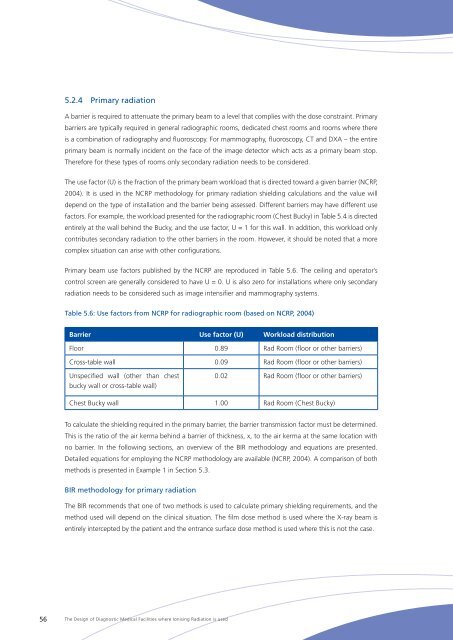The Design of Diagnostic Medical Facilities where ... - ResearchGate
The Design of Diagnostic Medical Facilities where ... - ResearchGate
The Design of Diagnostic Medical Facilities where ... - ResearchGate
You also want an ePaper? Increase the reach of your titles
YUMPU automatically turns print PDFs into web optimized ePapers that Google loves.
5.2.4 Primary radiation<br />
A barrier is required to attenuate the primary beam to a level that complies with the dose constraint. Primary<br />
barriers are typically required in general radiographic rooms, dedicated chest rooms and rooms <strong>where</strong> there<br />
is a combination <strong>of</strong> radiography and fluoroscopy. For mammography, fluoroscopy, CT and DXA – the entire<br />
primary beam is normally incident on the face <strong>of</strong> the image detector which acts as a primary beam stop.<br />
<strong>The</strong>refore for these types <strong>of</strong> rooms only secondary radiation needs to be considered.<br />
<strong>The</strong> use factor (U) is the fraction <strong>of</strong> the primary beam workload that is directed toward a given barrier (NCRP,<br />
2004). It is used in the NCRP methodology for primary radiation shielding calculations and the value will<br />
depend on the type <strong>of</strong> installation and the barrier being assessed. Different barriers may have different use<br />
factors. For example, the workload presented for the radiographic room (Chest Bucky) in Table 5.4 is directed<br />
entirely at the wall behind the Bucky, and the use factor, U = 1 for this wall. In addition, this workload only<br />
contributes secondary radiation to the other barriers in the room. However, it should be noted that a more<br />
complex situation can arise with other configurations.<br />
Primary beam use factors published by the NCRP are reproduced in Table 5.6. <strong>The</strong> ceiling and operator’s<br />
control screen are generally considered to have U = 0. U is also zero for installations <strong>where</strong> only secondary<br />
radiation needs to be considered such as image intensifier and mammography systems.<br />
Table 5.6: Use factors from NCRP for radiographic room (based on NCRP, 2004)<br />
Barrier Use factor (U) Workload distribution<br />
Floor 0.89 Rad Room (floor or other barriers)<br />
Cross-table wall 0.09 Rad Room (floor or other barriers)<br />
Unspecified wall (other than chest<br />
bucky wall or cross-table wall)<br />
0.02 Rad Room (floor or other barriers)<br />
Chest Bucky wall 1.00 Rad Room (Chest Bucky)<br />
To calculate the shielding required in the primary barrier, the barrier transmission factor must be determined.<br />
This is the ratio <strong>of</strong> the air kerma behind a barrier <strong>of</strong> thickness, x, to the air kerma at the same location with<br />
no barrier. In the following sections, an overview <strong>of</strong> the BIR methodology and equations are presented.<br />
Detailed equations for employing the NCRP methodology are available (NCRP, 2004). A comparison <strong>of</strong> both<br />
methods is presented in Example 1 in Section 5.3.<br />
BIR methodology for primary radiation<br />
<strong>The</strong> BIR recommends that one <strong>of</strong> two methods is used to calculate primary shielding requirements, and the<br />
method used will depend on the clinical situation. <strong>The</strong> film dose method is used <strong>where</strong> the X-ray beam is<br />
entirely intercepted by the patient and the entrance surface dose method is used <strong>where</strong> this is not the case.<br />
56<br />
<strong>The</strong> <strong>Design</strong> <strong>of</strong> <strong>Diagnostic</strong> <strong>Medical</strong> <strong>Facilities</strong> <strong>where</strong> Ionising Radiation is used
















